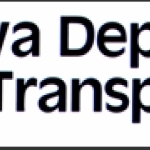- Sektör: Government; Transportation
- Number of terms: 1862
- Number of blossaries: 0
- Company Profile:
Iowa Department of Transportation (DOT) is the state agency responsible for the organization, construction, and maintenance of the of Iowa's highway system. Located in Ames, Iowa DOT is also responsible for licensing drivers and programming and planning for aviation, rail, and public transit.
The action of reducing the vibration of an object. This tends to return the vibrating object to its original position.
Industry:Construction
A structural frame in which the members are connected together without hinges.
Industry:Construction
A bridge sufficiency rating includes a multitude of factors: inspection results of the structural condition of the bridge, traffic volumes, number of lanes, road widths, clearances, and importance for national security and public use, to name just a few. The sufficiency rating is calculated per a formula defined in Federal Highway Administration’s Recording and Coding Guide for the Structure Inventory and Appraisal of the Nation’s Bridges. This rating is indicative of a bridge’s sufficiency to remain in service. The formula places 55 percent value on the structural condition of the bridge, 30 percent on its serviceability and obsolescence, and 15 percent on its essentiality to public use.
The point calculation is based on a 0-100 scale and it compares the existing bridge to a new bridge designed to current engineering standards.
The bridge’s sufficiency rating provides an overall measure of the bridge’s condition and is used to determine eligibility for federal funds. Bridges are considered structurally deficient if significant load carrying elements are found to be in poor condition due to deterioration or the adequacy of the waterway opening provided by the bridge is determined to be extremely insufficient to point of causing intolerable traffic interruptions.
Every bridge constructed goes through a natural deterioration or aging process, although each bridge is unique in the way it ages.
The fact that a bridge is classified under the federal definition as “structurally deficient" does not imply that it is unsafe. A structurally deficient bridge, when left open to traffic, typically requires significant maintenance and repair to remain in service and eventual rehabilitation or replacement to address deficiencies. To remain in service, structurally deficient bridges are often posted with weight limits to restrict the gross weight of vehicles using the bridges to less than the maximum weight typically allowed by statute.
To be eligible for federal aid the following is necessary (a local match is required):
* Replacement: bridge must have a sufficiency rating of less than 50 and * Repair: bridge must have a sufficiency rating of less than 80 and the jurisdiction is prevented from using any additional federal aid for 10 years.
Industry:Construction
One of the oldest and strongest types of bridges, the arch has been used in bridge building since the Roman era. An arch supports weight by compression on an axis or keystone. The axis or keystone transfers the stress of gravity (the traffic load) outward toward the base of the arch. Supports called abutments absorb the pressure and stop the ends of the bridge from spreading apart. Most arch bridges have vertical supports called spandrels that distribute the weight on the deck to the arch below.
The first arch bridges were built of stone but now are constructed of concrete or steel for greater strength and durability. Arch bridges are strong because the entire structure is under compression. Therefore, they must be built of materials that are strong under compression. Putting more weight on the arch actually compresses the material and makes the structure more rigid. Most arch bridges span between 200-800 feet.
Industry:Construction
A description of the sideview of a bridge having relatively steep approach embankments leading to the bridge deck.
Industry:Construction
A long, multi-span structure, especially one constructed of concrete. More commonly used in relation to structures carrying motor vehicles. Trestle is the term for a similar structure when used in relation to railroads.
Industry:Construction
A truss that carries its traffic through the interior of the structure with crossbracing between the parallel top and bottom chords. Compare to deck truss and pony truss.
Industry:Construction
A plate girder bridge is a bridge supported by two or more plate girders. The plate girders are typically I-beams made up from separate structural steel plates (rather than rolled as a single cross-section), which are welded (or occasionally bolted or riveted) together to form the vertical web and horizontal flanges of the beam. In some cases, the plate girders may be formed in a Z-shape rather than I-shape.
Plate girder bridges are suitable for short to medium spans and may support railroads, highways or other traffic.
In the deck-type bridge, a steel or reinforced concrete bridge deck is supported on top of two or more plate girders, and may act compositely with them. Additional beams may span across between the main girders, for example in the form of bridge known as ladder-deck construction. Also, further elements may be attached to provide cross-bracing and prevent the girders from buckling.
Industry:Construction
AASHTO is a nonprofit, nonpartisan association representing highway and transportation departments. Its guides and specifications are used to describe loading requirements for highway (vehicular) bridges.
Industry:Construction
